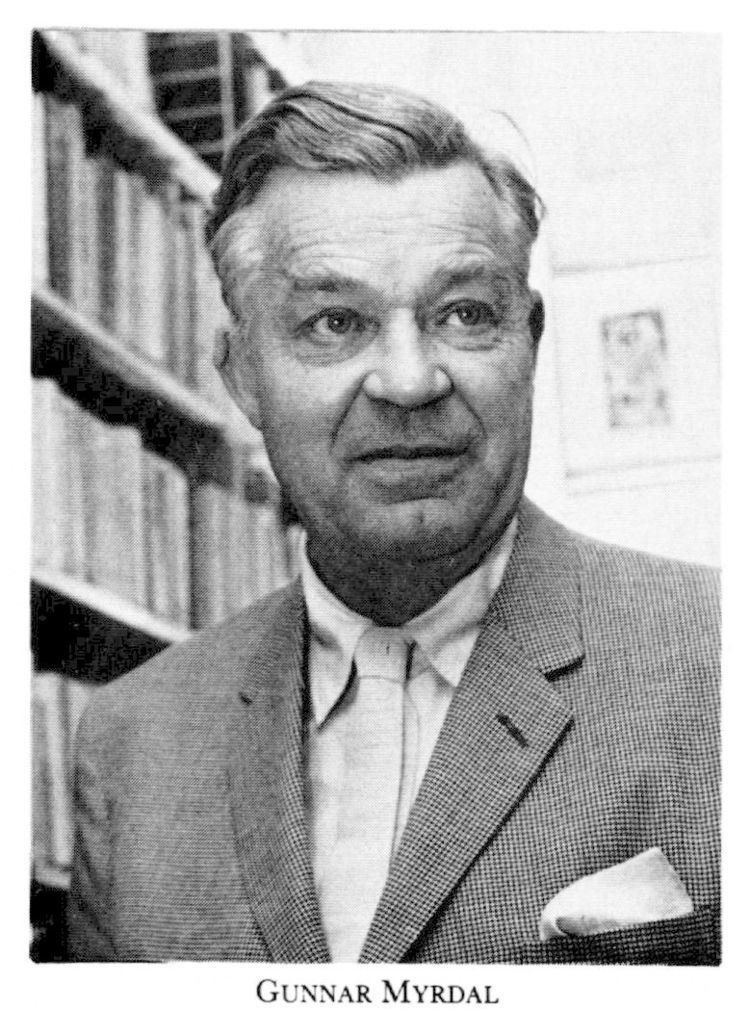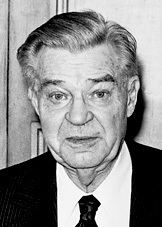Nationality Sweden Died May 17, 1987, Danderyd | Role Economist Name Gunnar Myrdal | |
 | ||
Fields Economics, Politics, Sociology Children Jan Myrdal, Sissela Bok, Kaj Folster Books An American Dilemma, Asian drama; an inquiry int, Crisis in the Populatio, The Political Element i, The Essential Gunnar M Similar People | ||
Institutions Stockholm University | ||
Voluntary Core Curriculum, Emory Williams Lecture, "Gunnar Myrdal's American Dilemma"
Karl Gunnar Myrdal ([ˈmyːɖɑːl]; 6 December 1898 – 17 May 1987) was a Swedish economist, sociologist and politician. In 1974, he received the Nobel Memorial Prize in Economic Sciences with Friedrich Hayek for "their pioneering work in the theory of money and economic fluctuations and for their penetrating analysis of the interdependence of economic, social and institutional phenomena." He is best known in the United States for his study of race relations, which culminated in his book An American Dilemma: The Negro Problem and Modern Democracy. The study was influential in the 1954 landmark U.S. Supreme Court Decision Brown v. Board of Education. In Sweden his work and political influence were important to the establishment of the Folkhemmet and the welfare state.
Contents
- Voluntary Core Curriculum Emory Williams Lecture Gunnar Myrdals American Dilemma
- Gunnar myrdal lecturing at ucla 5 4 1966
- Childhood
- Education and early career
- Career
- Personal life
- Contributions to the philosophy of knowledge
- Publications
- References

Gunnar myrdal lecturing at ucla 5 4 1966
Childhood
Myrdal was born on 6 December 1898 in Gustafs, Sweden, to Karl Adolf Pettersson (1876–1934), a railroad employee, and his wife Anna Sofia Karlsson (1878–1965). He took the name Myrdal in 1914 after his ancestors' farm Myr in Dalarna.
Education and early career
There is a possibly apocryphal story about an interaction between him and Gustav Cassel, where Cassel was reported to say, "Gunnar, you should be more respectful to your elders, because it is we who will determine your promotion," and he replied, "Yes, but it is we who will write your obituaries."
Gunnar Myrdal graduated with a law degree from Stockholm University in 1923 and a doctorate in economics in 1927. In 1919, he met Alva Reimer, whom he married in 1924.
In Gunnar Myrdal's doctoral dissertation, published in 1927, he examined the role of expectations in price formation. His analysis strongly influenced the Stockholm school. He built on Knut Wicksell's theories of cumulative process of endogenous money, stressing the importance of Knightian uncertainty and Ex ante and Ex post expectations role in the economic process.
Between 1925 and 1929 he studied in Britain and Germany. He was a Rockefeller Fellow and visited the United States in 1929–1930. During this period he published his first books, including The Political Element in the Development of Economic Theory. Returning to Europe, he served for one year as associate professor in the Graduate Institute of International Studies, Geneva, Switzerland.
Gunnar Myrdal was at first fascinated by the abstract mathematical models coming into fashion in the 1920s, and helped found the Econometric Society in London. Later, however, he accused the movement of ignoring the problem of distribution of wealth in its obsession with economic growth, of using faulty statistics and substituting Greek letters for missing data in its formulas and of flouting logic. He wrote, "Correlations are not explanations and besides, they can be as spurious as the high correlation in Finland between foxes killed and divorces." Professor Myrdal was an early supporter of the theses of John Maynard Keynes, although he maintained that the basic idea of adjusting national budgets to slow or speed an economy was first developed by him and articulated in his book Monetary Economics, published in 1932, four years prior to Keynes' General Theory of Employment, Interest and Money.
William Barber’s comment upon Myrdal’s work on monetary theory goes like this:
If his contribution had been available to readers of English before 1936, it is interesting to speculate whether the ‘revolution’ in macroeconomic theory of the depression decade would be referred to as 'Myrdalian' as much as 'Keynesian'.
Economist G. L. S. Shackle claimed the importance of Gunnar Myrdal's analysis by which saving and investment are allowed to adjust ex ante to each other. However, the reference to ex ante and ex post analysis has become so usual in modern macroeconomics that the position of Keynes to not include it in his work was currently considered as an oddity, if not a mistake. As Shackle put it:
Myrdalian ex ante language would have saved the General Theory from describing the flow of investment and the flow of saving as identically, tautologically equal, and within the same discourse, treating their equality as a condition which may, or not, be fulfilled.
Gunnar Myrdal also developed the key concept circular cumulative causation, a multi-causal approach where the core variables and their linkages are delineated.
Career
Gunnar Myrdal became professor at the Stockholm School of Economics 1933. At the Stockholm School of Economics he became good friends with Bertil Ohlin, professor in economics at the same university 1929-1965. The two became the leading proponents of the Stockholm school. Myrdal was professor of economics at Stockholm School of Economics for 15 years, until 1947.
He became a Social Democratic Member of Parliament from 1933 and from 1945 to 1947 he served as Trade Minister in Tage Erlander's government. During this period he was heavily criticised for his financial agreement with the Soviet Union. At the same time he was accused of being responsible for the Swedish monetary crisis in 1947.
He coauthored with his wife, Alva Myrdal, the Crisis in the Population Question (Swedish: Kris i befolkningsfrågan, 1934). The work of Gunnar and Alva inspired policies adopted by the Minister of Social Affairs, Gustav Möller, to provide social support to families.
Gunnar Myrdal headed a comprehensive study of sociological, economic, anthropological and legal data on race relations in the United States funded by the Carnegie Corporation, starting in 1938. The result of the effort was Gunnar Myrdal's best-known work, An American Dilemma: The Negro Problem and Modern Democracy, published in 1944, written with the collaboration of R. M. E. Sterner and Arnold Rose. He characterized the problem of race relations as a dilemma because of a perceived conflict between high ideals, embodied in what he called the "American Creed," on the one hand and poor performance on the other. In the generations since the Civil War, the U.S. had been unable to put its human rights ideals into practice for the African-American tenth of its population. This book was cited by the U.S. Supreme Court in its 1954 decision in Brown v. Board of Education, which outlawed racial segregation in public schools. Myrdal planned on doing a similar study on gender inequality, but he could not find funding for this project and never completed it.
During World War II, Gunnar Myrdal was staunchly, publicly anti-Nazi. Together with his wife, Alva, he wrote Contact with America in 1941, which praised the United States' democratic institutions.
Gunnar Myrdal became the Executive Secretary of the United Nations Economic Commission for Europe in 1947. During his tenure, he founded one of the leading centers economic research and policy development. After ten years in the position, Dr. Myrdal resigned as Executive Secretary in 1957. In 1956 and 1957, he was able to publish An International Economy, Problems and Prospects, Rich Lands and Poor and Economic Theory and Underdeveloped Regions. Myrdal was also a signatory of the 1950 UNESCO statement The Race Question, which rebuts the theories of racial supremacy and purity, and also influenced the Brown v. Board of Education decision. In 1956, Myrdal wrote the foreword for African American author Richard Wright's The Color Curtain: A Report on the Bandung Conference.
Between 1960 and 1967, he was a professor of international economics at Stockholm University. In 1961, he founded the Institute for International Economic Studies at the University. Throughout the 1960s, he worked on a comprehensive study of trends and policies in South Asia for the Twentieth Century Fund. The study culminated in his three-volume Asian Drama: An Inquiry into the Poverty of Nations, published in 1968. In 1970, he published a companion book called The Challenge of World Poverty, where he laid out what he believed to be the chief policy solutions to the problems he outlined in Asian Drama.
Gunnar Myrdal strongly opposed the Vietnam War. In Asian Drama, Myrdal predicted that land reform and pacification would fail in Vietnam and urged the United States to begin negotiations with North Vietnam. After returning to Sweden, he headed the Swedish Vietnam Committee and became co-chair of International Commission of Inquiry Into U.S. War Crimes in Indochina. He also presided over the Stockholm International Peace Research Institute, an international watch-dog for the arms trade. He was one of the signers of the Humanist Manifesto.
In 1967 Myrdal received an honorary doctorate from Sir George Williams University, which later became Concordia University.
In 1971 both he and his wife received honorary doctorates from Gustavus Adolphus College in Saint Peter, Minnesota.
He shared the Bank of Sweden Prize in Economic Sciences (otherwise known as the Nobel Memorial Prize in Economics) with Friedrich Hayek in 1974 but argued for its abolition because it had been given to such "reactionaries" as Friedrich Hayek and Milton Friedman.
During 1974-1975, he served as visiting professor at NYU.
Myrdal received an Honorary Doctorate from Heriot-Watt University in 1979.
Personal life
Myrdal was married to politician and diplomat Alva Myrdal in 1924, and together had two daughters, Kaj Fölster (mother of Swedish economist Stefan Fölster) and Sissela Bok, and a son, Jan Myrdal.
Myrdal was hospitalized for two months before he died in a hospital in Danderyd, near Stockholm, on 17 May 1987. His daughter Kaj Fölster and his grandson, Janken Myrdal, were present.
Contributions to the philosophy of knowledge
Gunnar Myrdal's scientific influence was not limited to economics. Through the introduction to "Asian Drama" with the title "The Beam in our Eyes" (a biblical reference; cf. Matthew 7:1–2) he introduced the approach mentioned as scientific relativism of values. This behavioral approach is narrowly connected to behavioralism and is built on the idea that the logical gulf between "is" and "ought" is more sophisticated than just dividing premises into categories. The articles edited in "Value in Social Theory" underlines Myrdal's importance to political science. As political science normally is considered more descriptive than economics, one might get the idea that Myrdal should not have dealt systematically with the values applied to economics. On the contrary, Myrdal connected social science, political science and economics as a practitioner.
Myrdal published many notable works, both before and after American Dilemma and, among many other contributions to social and public policy, founded and chaired the Stockholm International Peace Research Institute. Internationally revered as a father-figure of social policy, he contributed to social democratic thinking throughout the world, in collaboration with friends and colleagues in the political and academic arenas. Sweden and Britain were among the pioneers of a welfare state and books by Myrdal (Beyond the Welfare State – New Haven, 1958) and Richard Titmuss (Essays on “The Welfare State” – London, 1958) unsurprisingly explore similar themes. Myrdal's theoretical key concept "circular cumulative causation" contributed to the development of modern Non-equilibrium economics.
